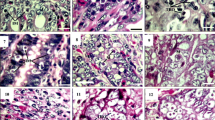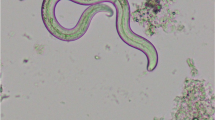Abstract
Higher infection rates were observed in gerbils and voles than in ICR mice after oral inoculation with eggs of a Japanese isolate ofTaenia crassiceps. Asexual reproduction ofT. crassiceps cysticerci was observed in all gerbils and voles infected i.p. with the cysticerci. However, ICR mice and Wistar rats were not suitable for the asexual proliferation ofT. crassiceps. The hooks of cysticerci from mice were smaller than those from gerbils. In experimentally infected puppies, parasite development was noted as follows: strobilation and initial differentiation of the genital primordia on day 7 postinoculation (p.i.), appearance of the testes on day 9, observation of the ovaries on day 10, and development of the lateral branches of the uterus on day 15. The prepatent period was 27–31 days. After day 15 p.i., most of the worms were recovered from the middle third of the small intestine. The number of proglottids shed per day by each strobila was about 1. The number of eggs contained in a gravid segment was about 13000.
Similar content being viewed by others
References
Abuladze KI (1964) Taeniata of animals and man, and diseases caused by them. Akademiya Nauk USSR, Moscow, pp 59–67 (translated by Israel's Program for Scientific Translation, Jerusalem, 1970)
Bona FV (1974) Skinning of cestodes of middle and large sizes for whole mounts. Technical note. Parassitologia (Rome) 16:257–259
Chernin J (1975) The growth of the metacestodes ofTaenia crassiceps in white mice. J Helminthol 49:297–300
Dorais FJ, Esch GW (1969) Growth rate of twoTaenia crassiceps strains. Exp Parasitol 25:395–398
Esch GW, Smyth JD (1976) Studies on the in vitro culture ofTaenia crassiceps. Int J Parasitol 6:143–149
Featherston DW (1969)Taenia hydatigena: I. Growth and development of the adult stage in the dog. Exp Parasitol 25:329–338
Fox LL, Kuhn RE, Esch GW (1971)Taenia crassiceps: antigenic comparison of two larval strains. Exp Parasitol 29:194–196
Freemans RS (1962) Studies on the biology ofTaenia crassiceps (Zeder, 1800) Rudolphi, 1810 (Cestoda). Can J Zool 40:969–990
Hopkins CA, Allen LM (1979)Hymenolepis diminuta: the role of the tail in determining the position of the worm in the intestine of the rat. Parasitology 79:401–410
Lubinsky G, Baron R (1970)Taenia crassiceps (Zeder, 1800) in metropolitan Winnipeg, Manitoba. Can J Zool 48:1144–1145
Moore J (1981) Asexual reproduction and environmental predictability in cestodes (Cyclophyllidea: Taeniidae). Evolution 35:723–741
Rausch R (1952) Studies on the helminth fauna of Alaska: XI. Helminth parasites of microtine rodents. Taxonomic considerations. J Parasitol 38:415–444
Rausch R (1959) Studies on the helminth fauna of Alaska: XXXV. On the identity of certain cestodes (Taeniidae) from foxes. Proc Helminthol Soc Wash 26:125–131
Rietschel G (1981) Beitrag zur Kenntnis vonTaenia crassiceps (Zeder, 1800) Rudolphi, 1810 (Cestoda, Taeniidae). Z Parasitenkd 65:309–315
Smyth JD, Miller HJ, Howkins AB (1967) Further analysis of the factors controlling strobilization, differentiation, and maturation ofEchinococcus granulosus in vitro. Exp Parasitol 21:31–41
Uchida A, Uchida K, Kamei A, Murata Y, Oku Y (1990) First record ofCysticercus longicollis (Taeniidae, Cestoda) from Japan. Jpn J Vet Sci 52 (in press)
Author information
Authors and Affiliations
Rights and permissions
About this article
Cite this article
Miyaji, S., Oku, Y., Kamiya, M. et al. Growth of a Japanese isolate ofTaenia crassiceps in intermediate and definitive hosts. Parasitol Res 76, 351–354 (1990). https://doi.org/10.1007/BF00928191
Accepted:
Issue Date:
DOI: https://doi.org/10.1007/BF00928191




